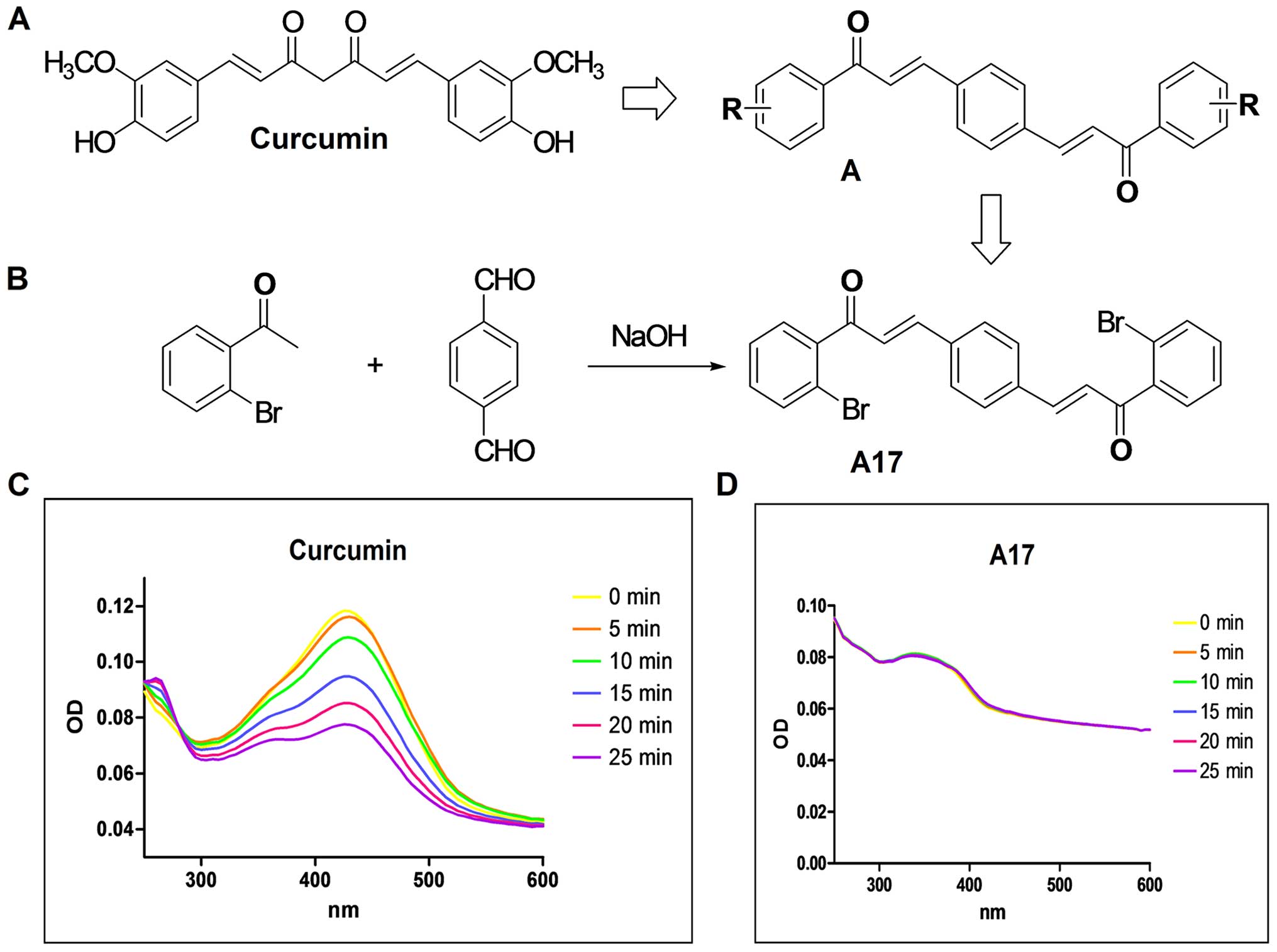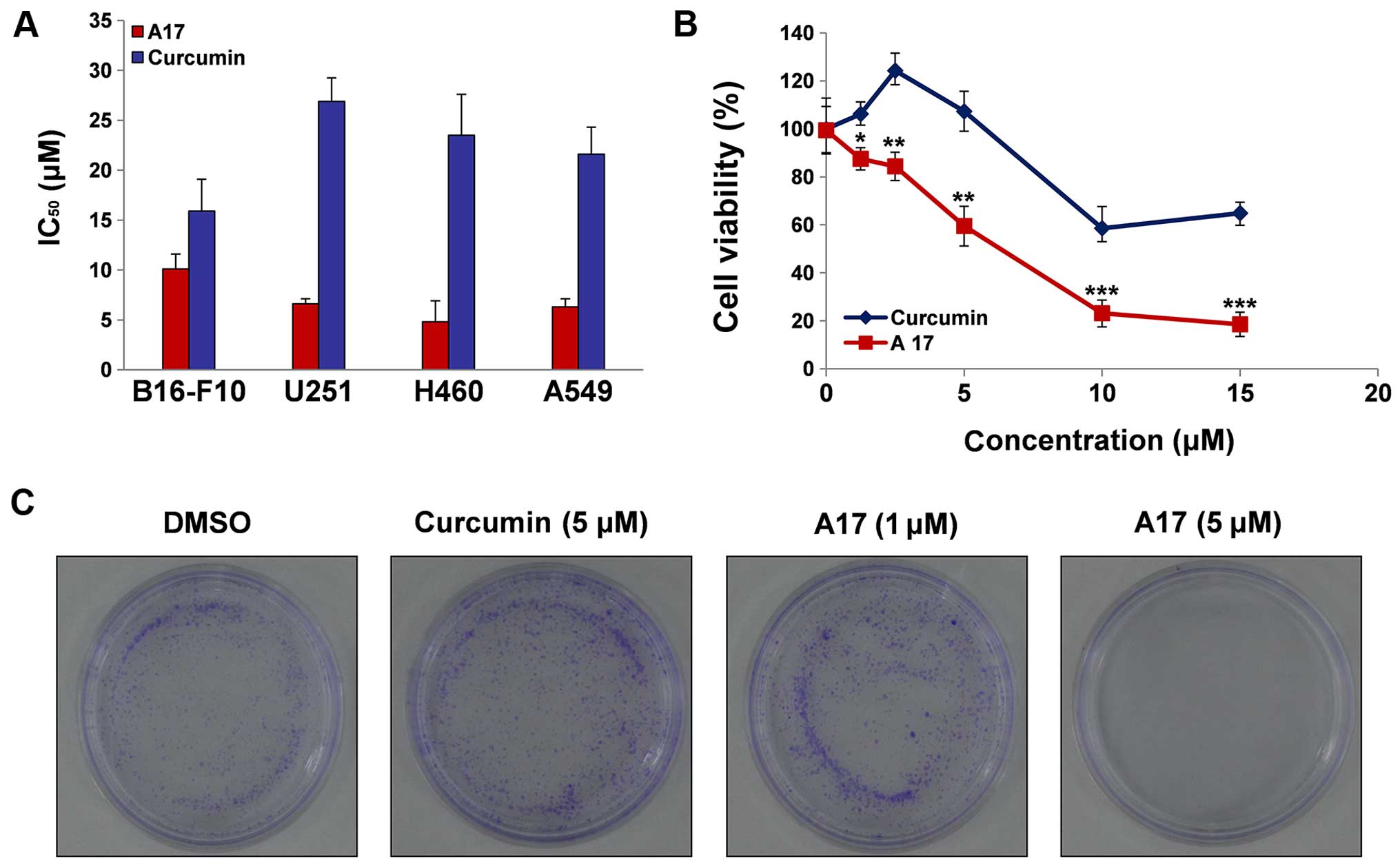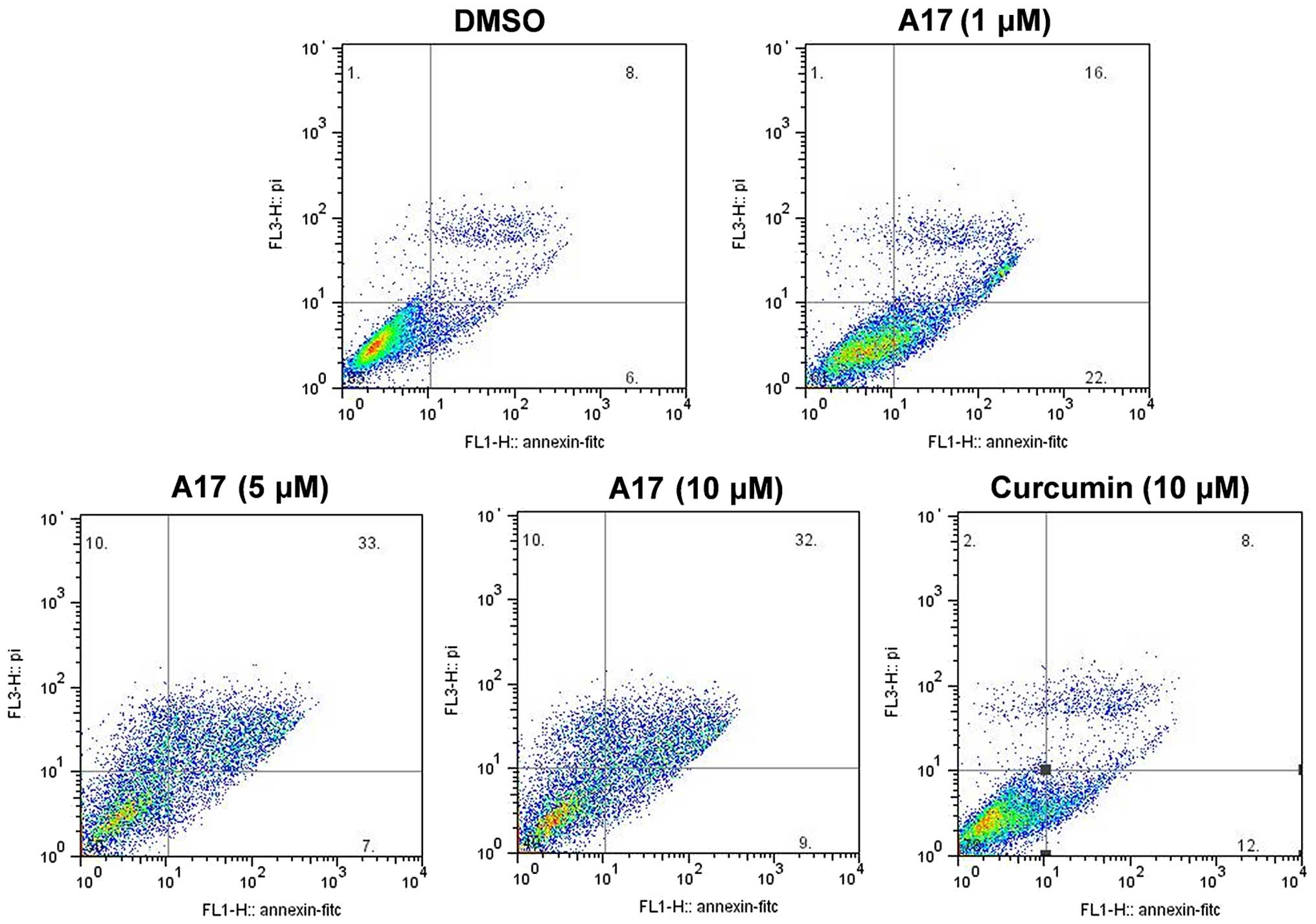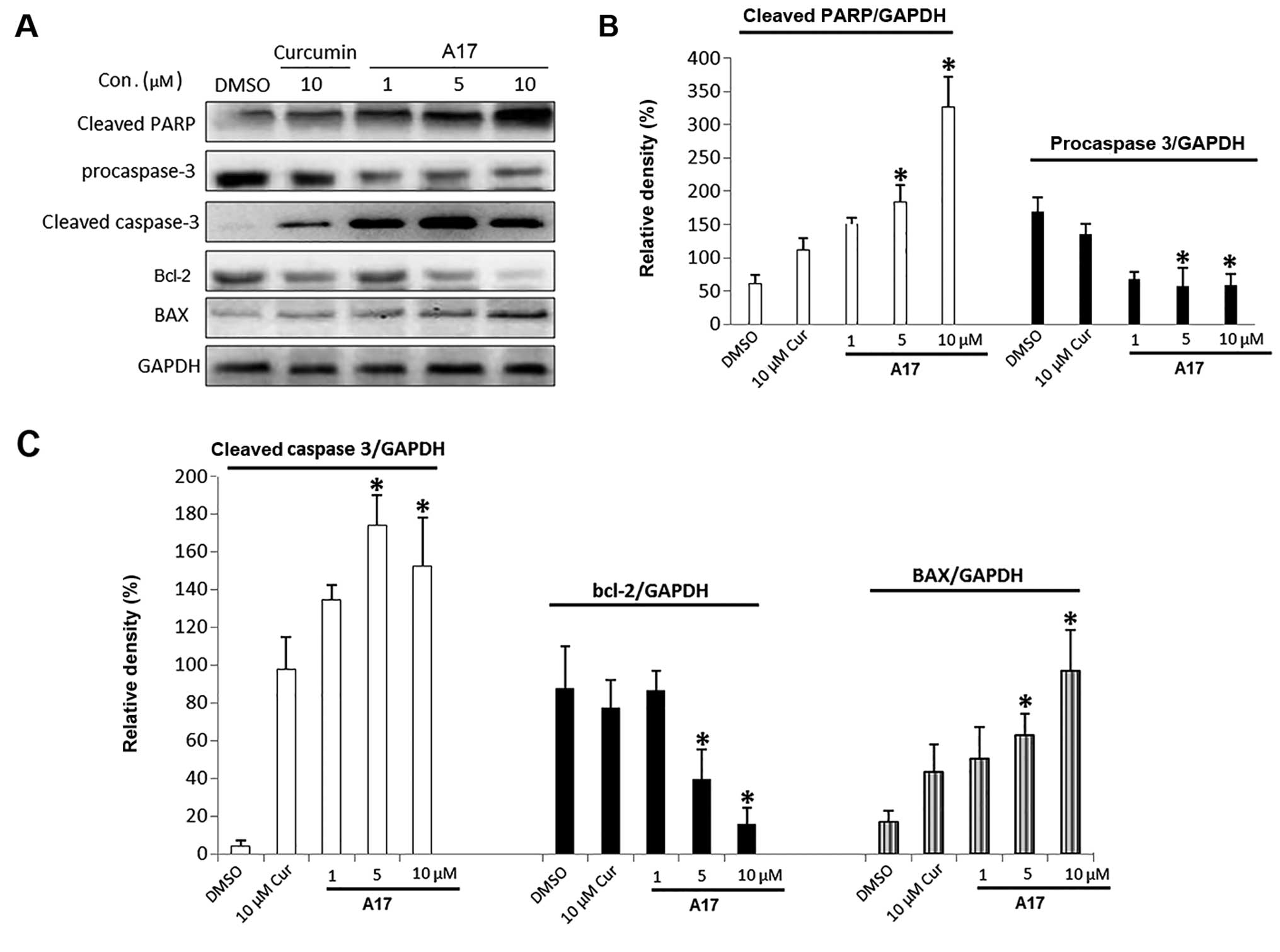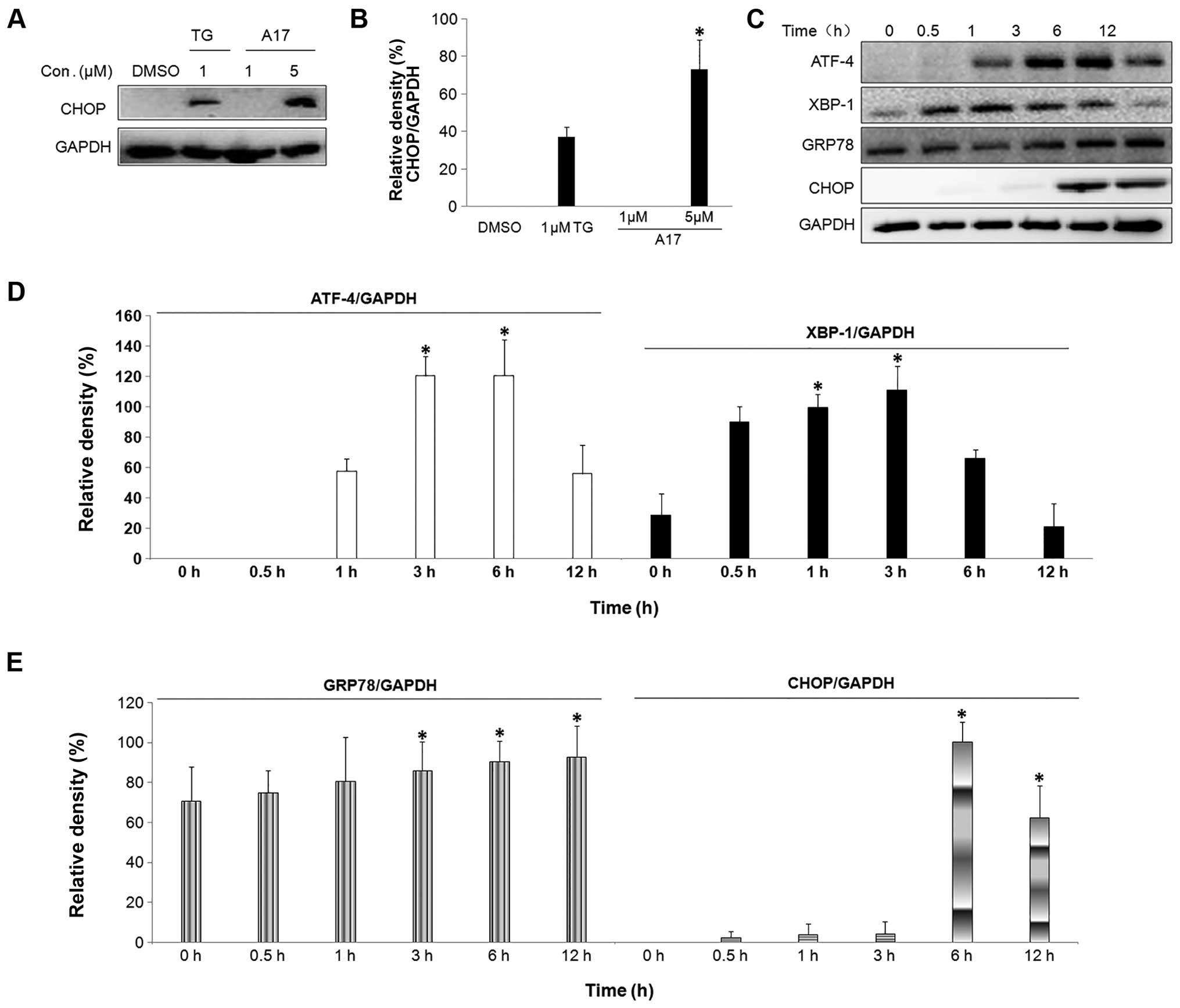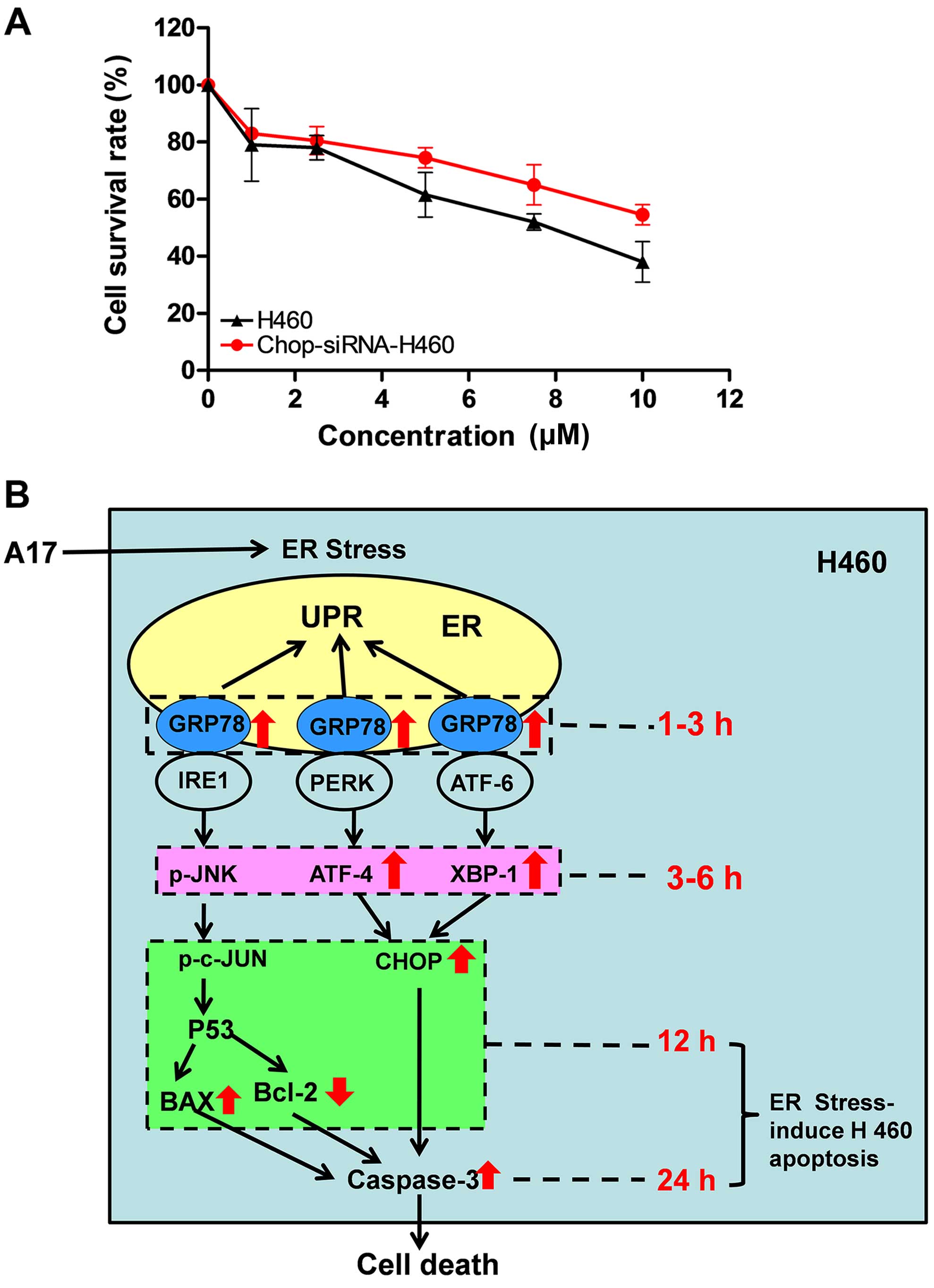A novel double carbonyl analog of curcumin induces the apoptosis of human lung cancer H460 cells via the activation of the endoplasmic reticulum stress signaling pathway
- Authors:
- Published online on: June 30, 2016 https://doi.org/10.3892/or.2016.4911
- Pages: 1640-1648
Abstract
Introduction
Previous studies have shown that the perturbation of endoplasmic reticulum (ER) function causes ER stress, which has been linked to numerous diseases. Yet, prolonged ER stress can activate apoptotic pathways of damaged cells (1). ER stress is related to the pathophysiology of cancer; therefore pharmacological interventions that effectively enhance tumor cell death by activating ER stress have attracted much attention for anticancer therapy (2,3). Various anticancer agents, such as paclitaxel (4), farnesol (5) and polyphyllin D (6), can induce cancer cell apoptosis by ER stress. Curcumin, a yellow compound, is isolated from the rhizome of the herb Curcuma longa. Over the last half-century, various bio-functions of curcumin have been revealed through extensive research. A few clinical trials have demonstrated that curcumin possesses anticancer effect, but was proposed as a more native chemoprevention agent in pancreatic and colon cancer (7). Various studies suggest that curcumin may induce the apoptosis of several types of cancer cells via ER stress (8–11). Curcumin was also reported to display its pro-apoptotic effects by inducing ER stress in acute promyelocytic leukemia (12), non-small cell lung cancer H460 cells (13) and human liposarcoma cells (14).
However, the instability and poor metabolic property of cucurmin have significantly limited its clinical application (15). Therefore, in the past few years, a series of curcumin analogs have been synthesized in our laboratory, in order to enhance its metabolic stability and pharmacological potency (1,16-22). Given that the β-diketone moiety of curcumin may lead to its instability and poor metabolic properties, by deleting this moiety, we designed many mono-carbonyl analogs of curcumin and three of them were discovered as the most efficient compounds against tumor cells with enhanced stability. Their chemical structures were respectively 06 [(1E,4E)-1,5-bis(2-bromophenyl) penta-1,4-dien-3-one], 12 [(2E, 5E)-2, 5-bis(4-(3-(dimethylamino) propoxy)benzylidene)cyclopentanone], and 19 [(1E,4E)-1,5-bis(2,3-dimethoxyphenyl)penta-1,4-dien-3-one] (17). To further develop new analogs of curcumin which can enhance stability and anticancer effects, we designed and screened novel double carbonyl analogs of curcumin. In the present study, we identified a novel double carbonyl analog of curcumin (named A17; Fig. 1), and described its stability and antitumor activity. The results showed that A17 has better stability and antitumor activity than curcumin.
Materials and methods
Chemicals and reagents
Curcumin was purchased from Sigma Chemical Co. (St. Louis, MO, USA). As shown in Fig. 1A and B, curcumin analog A17 was synthesized and recrystallized by CH2C2/EtOH. Its structure was identified by MS and 1H-NMR analyses and its purity (99.50%) was determined using HPLC. The CellTiter-Glo kit was purchased from Promega Corporation (Madison, WI, USA). FITC Annexin V Apoptosis Detection kit I was purchased from BD Pharmingen (Franklin Lakes, NJ, USA). Nitrocellulose membranes and enhanced chemiluminescence reagents were obtained from Bio-Rad (Hercules, CA, USA). Antibodies including anti-cleaved PARP, anti-pro-caspase-3, anti-Bcl-2, anti-BAX, anti-GAPDH, anti-CHOP, anti-ATF-4, anti-XBP-1, anti-GRP78, goat anti-mouse IgG-HRP, goat anti-rabbit IgG-HRP and donkey anti-goat IgG-HRP were purchased from Santa Cruz Biotechnology (Santa Cruz, CA, USA), and anti-cleaved caspase-3 antibody was purchased from Cell Signaling Technology (Danvers, MA, USA). The Ambion RNAqueous kit was purchased from Applied Biosystems Inc. (Foster City, CA, USA). All other reagents and solvents used were of analytical grade.
Cell lines
Human lung carcinoma cell line NCI-H460 was purchased from the American Type Culture Collection (ATCC; Manassas, VA, USA). The B16-F10 (mouse B16-F10 malignant melanoma cells), U251 (human glioma cell U251), and A549 cells were all purchased from the Shanghai Institute of Biosciences and Cell Resources Center (Chinese Academy of Sciences, Shanghai, China). B16-F10 and U251 were cultured in RPMI-1640 medium, whereas NCI-H460 and A549 were cultured in Dulbecco's modified Eagle's medium (DMEM) (both from Invitrogen, Carlsbad, CA, USA) with high-glucose media; the four types of cells were supplemented with 10% heat-inactivated fetal bovine serum (FBS) (Atlanta Biologicals Inc., Lawrenceville, GA, USA) and 100 U/ml penicillin-streptomycin (Mediatech, Inc., Manassas, VA, USA) and incubated at 37°C with 5% CO2.
Stability test
To determine the optical density (OD) of A17 and curcumin, 10 µl A17 or curcumin was added into each cuvette and then the absorbance was detected at once from 200 to 600 nm. OD was measured once every 5 min, and three independent experiments were conducted.
Methyl thiazolyl tetrazolium (MTT) assay
MTT assay was conducted according to the basic specifications described by Ye et al (23), but with slight modification. Briefly, B16-F10, U251, H460 and A549 cells (100 µl/well) at the logarithmic phase were seeded and cultured in a 96-well plate at 37°C. After 24 h, A17 was dissolved and diluted with dimethyl sulfoxide (DMSO) to a final concentration of 60, 12, 2.4, 0.48 or 0.096 µg/ml, and directly added to the culture medium in a 96-well plate and incubated for 72 h before the MTT assay. Curcumin was used as the positive control. MTT (5 mg/ml) dissolved in NaCl solution (0.9%) was added to each well of the plate. After incubation in a CO2 incubator for 3 h, the cells were dissolved in 100 µl of DMSO and then analyzed in a multi-well plate reader at 570 nm.
Cell viability assay
Freshly resuspended H460 cells were seeded into 96-well plates at 5×103 cells/well overnight, and then the cells were treated with various concentrations of A17 or curcumin. The compounds were dissolved in DMSO and added to the culture medium (final concentration of 1.25, 2.5, 5, 10 and 15 µM) and incubation was carried out for 24 h in an incubator at 37°C with 5% CO2. Cell viability was observed by microscopy and evaluated with the CellTiter-Glo kit at different time points. Absorbance was measured at 450 nm to determine the number of viable cells.
Colony formation assay
H460 cells were placed into a 6-well plate at 1×103 cells/well and cultured overnight. After starved cultivation for 24 h, the cells were treated for a week with 1 and 5 µM of A17, 5 µM of curcumin and DMSO (were used as a control). The number of surviving colonies was counted after staining with crystal violet solution and then photographed. Each experiment was performed in triplicate wells 3 times.
Flow cytometric analysis
H460 cells were plated in a 6-mm plate for 6 h and then treated with A17 (1, 5 and 10 µM), curcumin (10 µM) or DMSO for 24 h, respectively. In addition, the cells were collected and stained with Annexin V and propidium iodide (PI) for 30 min at 37°C when 100 mg/ml RNAse and 0.1% Triton X-100 were present. Flow cytometric analysis was performed using FACSCalibur (BD Biosciences, San Jose, CA, USA).
Western blot analysis
H460 cells were washed and collected with PBS after treatment, and lysed in lysis buffer containing 50 mmol/l Tris-HCl (pH 7.4), 150 mmol/l NaCl, 1% NP40 and 0.1% SDS. After the protein concentration was determined by BCA protein assays, protein samples were electrophoresed by 10% SDS-PAGE gel before proteins were transferred to nitrocellulose membranes. Each membrane was blocked with Tris-buffered saline (pH 7.6) containing 0.05% Tween-20 and 5% non-fat milk for 1 h at room temperature. After being washed with TBS 3 times, the nitrocellulose membrane was probed with the specific primary antibody at 4°C overnight followed by incubation with secondary antibodies conjugated with horseradish peroxidase and visualized using enhanced chemiluminescence reagents.
Construction of lentiviral siRNA for CHOP
To specifically target the nucleotides of CHOP, lentiviral siRNA for CHOP was constructed according to the basic specifications described by Liang et al (18). The sense sequence of the siRNA cassettes was designed with the siRNA target finder (Ambion, Austin, TX, USA), and the sequence of CHOP siRNA was 5′-GCAGGAAATCGAGCGCCTGAC-3′.
Statistical analysis
Student's t-test was employed to analyze the differences between data sets. The data analysis was performed using GraphPad Prism 4.0 (GraphPad, San Diego, CA, USA). Differences were considered to indicate a statistically significant result at p<0.05.
Results
Structures of A17 and curcumin and their activity against human tumor cell lines
Fig. 1A and B show the design and structural skeleton of the novel double carbonyl analogs of curcumin (A17). According to the characteristic absorption peak of A17 and curcumin in Fig. 1C and D, A17 is more stable than curcumin, and Fig. 2A shows that A17 exhibited good antiproliferative effect against B16-F10, U251, H460 and A549 cell lines, which were chosen for the present study. IC50 values of A17 and curcumin against the above mentioned cell lines were determined by an MTT assay (Fig. 2A). Curcumin showed cytotoxicity against B16-F10, U251, H460 and A549 cells with IC50 values of 15.9±3.2, 26.9±23.4, 23.5±4.1 and 21.6±2.7 µM, respectively; by contrast, A17 displayed stronger cytotoxicity than curcumin, with IC50 values reaching 10.1±1.5, 6.6±0.1, 4.8±2.1 and 6.3±0.8 µM, respectively.
H460 cell death is induced by A17
After H460 cells were treated with A17 or curcumin at different concentrations (0, 1.25, 2.5, 5, 10 and 15 µM) for 24 h, cell viability was determined by the CellTiter-Glo kit assay. A17 at different doses, induced H460 cell death more effectively than curcumin at the same doses, as shown in Fig. 2B (p<0.01), and A17 ranging from 1.25 to 15 µM dose-dependently decreased cell survival. As shown in Fig. 2B, after 24 h of treatment with A17 or curcumin at 10 µM, A17 significantly reduced H460 cell viability (22.71%) when compared with curcumin (58.2%). Subsequently, the antiproliferative effect of H460 cells was identified by colony formation assay. The results showed that, compared with curcumin and DMSO, A17 significantly reduced the number of colonies formed by the H460 cells at 5 µM (Fig. 2C). Flow cytometric analysis was used to assess the effects of A17 and curcumin on the induction of apoptosis in H460 cells. Fig. 3 showed that A17 increased H460 apoptosis in a dose-dependent manner after 6 h of treatment. After H460 cells were treated with A17 at 5 µM or curcumin at 10 µM, only a cell apoptosis rate of 8% was detected in the curcumin group, whereas 33% H460 cell apoptosis was induced in the A17 group. We further investigated the A17-induced H460 cell death by western blot analysis. As shown in Fig. 4, cleaved PARP, procaspase-3, cleaved caspase-3, Bcl-2 and BAX are apoptosis-related proteins. A17 dose-dependently enhanced H460 cell apoptosis after 12–24 h of treatment by increasing the expression of BAX, cleaved caspase-3, and cleaved PARP while decreasing the expression of Bcl-2 and procaspase-3.
A17 causes ER stress in the H460 cells
Glucose-regulated protein/immunoglobulin heavy chain-binding protein (GRP78) is the gatekeeper to the activation of ER stress (24). Thus, the protein expression of GRP78 was measured after A17 treatment. Fig. 5C and E show that the protein expression of GRP78 was increased at 3 h following treatment with A17 at 5 µM, whereas no significant increase was detected in the curcumin-treated group (18). In addition, western blot analysis revealed that the protein expression of GRP78 increased in a time-dependent manner at 1–12 h after the cells were treated with A17 at 5 µM. Thereafter, we also examined the expression levels of the downstream X-box binding protein 1 (XBP-1) and activating transcription factor 4 (ATF-4) in H460 cells treated with 5 µM A17 or curcumin using western blot analysis. The time course results showed that the treatment with A17 at 5 µM induced the expression of ATF-4 (6 h after treatment) and XBP-1 (3 h after treatment) to peak (Fig. 5C and D), whereas no significant increase could be seen in the 5 µM curcumin-treated H460 cells (18).
CHOP induction may be most sensitive to ER stress response, and CHOP is regarded as a marker of the commitment to ER stress-induced apoptosis (25). The transcription of the CHOP gene is induced by the unfolded protein response (UPR) including ATF-4 and XBP-1 pathways in the process of ER stress (26). In the present study, we demonstrated that A17 obviously increased CHOP at the protein level. Fig. 5A and B indicated that A17 induced CHOP protein upregulation in a dose-dependent manner. Similarly, CHOP expression was not detectable in curcumin-treated cells. As shown in Fig. 5C and E, the CHOP protein expression was noticeably increased after H460 cells were exposed to A17 for 6 and 12 h, and reached its peak at 12 h, but curcumin at 5 µM had no effect on CHOP protein levels.
All upstream signals finally result in caspase activation to finish the execution of ER stress-induced apoptosis (27). As shown in Fig. 4, we tested the downstream events of ER stress-mediated apoptosis after A17-induced ER stress. The western blot analysis results showed that the cleavage of procaspase-3 was detected after A17 treatment for 24 h. However, caspase-3 was not able to be activated by curcumin at this concentration. These results demonstrate that the caspase signal is related to the ER stress-mediated apoptotic pathway induced by A17.
A17-induced H460 cell death is suppressed by reducing CHOP expression
To further prove that ER stress plays an important role in the process of A17-induced H460 cell apoptosis, we constructed a lentiviral vector that contained an siRNA targeting the CHOP gene and transiently transfected it into H460 cells. We detected the titers by counting EGFP-expressing cells after 48 h via fluorescence microscopy. As a result, we found that over 67% of the H460 cells were transfected using the lentiviral siRNA. In addition, to verify that A17-induced H460 cell death was suppressed by reducing CHOP expression, CHOP siRNA-tranfected H460 cells were treated using A17 at the indicated concentrations (0, 2, 4, 6, 8, 10 and 20 µM) for 24 h. Compared with the control group, cell apoptosis induced by A17 was markedly decreased when CHOP expression in H460 cells was silenced (Fig. 6A). CHOP is a key protein in ER stress, thus, these results suggest that A17-induced cell apoptosis is at least partially mediated by the ER stress pathway.
Discussion
Curcumin, also known as diferuloylmethane, is extracted from the root of Curcuma longa and has been widely used as a therapeutic agent for several different types of cancers in clinical trials (19). However, numerous studies indicate that its poor bioavailability and pharmacokinetic profiles have limited its application in anticancer therapy (15,28,29). The chemical modification of curcumin is an effective way to obtain potential analogs with enhanced bioavailability and antitumor activity (16,18,19,30–34). Given that the β-diketone moiety of curcumin may cause its instability and poor metabolic property, we previously deleted the moiety to design a series of mono-carbonyl analogs of curcumin (17). Through the analysis of cytotoxic screening experiment, we found that 06, 12 and 19 of curcumin analogs showed enhanced toxic effects against human lung cancer H460 cells, and the IC50 values were <10 µM (18). To further improve the stability and anticancer effect of curcumin, we designed a double carbonyl analog of curcumin (named A17; Fig. 1A and B). A17 had better stability and improved pharmacokinetic profiles than curcumin. Subsequently, an MTT assay for A17 against human lung cancer H460 cells was performed, and A17 was a more efficient compound than curcumin against H460 cells with IC50 <5 µM, thereby suggesting that A17 also has much higher activity than curcumin (Fig. 2A).
In rapidly growing tumors, when cancer cells are continuously exposed to harsh microenvironments of hypoxia and nutritional deprivation, this leads to ER stress (35). The UPR pathways of most normal cells remain quiescent, since they do not undergo an active ̔stress̓ response. The difference between normal cells and tumor cells allows for the agents that target ER stress to implement the specificity of cancer therapy. Some data from clinical trials support the hypothesis that the regulation of ER stress may raise the curative effect of chemotherapy drugs and that ER stress-mediated apoptotic pathways may provide new targets for antitumor drugs (21). Previous studies have shown that curcumin induces the apoptosis of human non-small cell lung cancer (NSCLC) H460 cells through ER stress and mitochondria-dependent pathways (13,27). Curcumin at >30 µM caused cytotoxicity in H460 cells via the induction of apoptosis, and apoptotic cell death was associated with the ER stress signaling pathway (18). In the present study, to develop novel antitumor agents via the ER stress-mediated mechanism, we tested the ability of A17 to increase the expression of CHOP, which is a hallmark of the ER stress-mediated apoptotic pathway. Fig. 5A shows that A17 induced CHOP overexpression in the H460 cells, thereby suggesting that A17 may have a different mechanism of antitumor action from that of the other analogs. Therefore, we revealed the exact molecular mechanism by which A17 causes ER stress-mediated cell apoptosis, as explained below. GRP78 is a member of a glucose-regulated protein family and is the gatekeeper of the activation of ER stress (24). ER has three transmembrane receptors: the PKR-like ER kinase (PERK), ATF-6 and IRE1. They usually combine with GRP78 and form a complex in the inactive state, respectively. However, in the process of UPR, once GRP 78 is combined with misfolded proteins, these transmembrane receptors are released from complexes, and then they monitor their downstream molecules and regulate ER stress (36). In the present study, after H460 cells were treated with A17 for 3 h, GRP78 protein expression was increased (Fig. 5C and E). Subsequently, we detected the A17-induced activation of PERK, ATF-6, and IRE1 by monitoring their downstream molecules: ATF-4, XBP-1, BAX and Bcl-2 (namely, p-JNK↑ → p-c-JUN↑ → P53↑ → BAX↑ and Bcl-2↓) at 6–12 h after A17 treatment, respectively (Figs. 4A and C; and 5C and D). These data indicate that the ER stress-dependent apoptotic pathway was triggered by A17.
After H460 cells were treated with A17 for 12 h, CHOP expression was also found to increase (Fig. 5A–C and E). In fact, CHOP is the common downstream activated protein in two signaling pathways of PERK and ATF-6; ATF-4 and XBP-1 activation lead to the upregulation of CHOP gene expression, thus triggering an ER stress-specific cascade for apoptosis. In addition, several members of the Bcl-2 family proteins, regarded as main regulators in the mitochondrial-mediated apoptotic pathway, are important in the ER stress downstream pathway (26,38,39). The phosphorylation of c-Jun activates the transcription factor P53 and the latter regulates Bcl-2 family proteins (26,38,39). As shown in Fig. 4A and C, after A17 treatment of H460 cells for 12 h, A17 dose-dependently increased the expression of BAX, but decreased the expression of Bcl-2.
Finally, caspase is activated by all of the upstream signals, which leads to the ordered and sequential dismantling of the cells until competion of the execution of ER stress-induced apoptosis (26,37). In different studies of ER stress-induced human cancer cell apoptosis, the cleavage and activation of caspase-3 has been observed (26,37,38,40). Fig. 4 suggests that A17 dose-dependently induced the cleavage and activation of caspase-3; the cleaved caspase-3 was able to cleave PARP (namely, the substrate of caspase-3), thereby resulting in the loss of PARP activity consequently leading to H460 cell apoptosis. In summary, our data confirmed the capacity of A17 to activate all key proteins at various phases of ER stress. Therefore, according to above relative results, we propose a signaling model of the development of ER stress-induced apoptosis induced by A17 (Fig. 6B).
The sensitivity of H460 cells to A17 treatment at concentrations ranging from 1.25 to 15 µM was further confirmed by the results of the cell viability and colony formation assays, and flow cytometric analysis, whereas curcumin did not display adequate activity at the indicated concentrations (Figs. 2 and 3). The above mentioned data suggest that ER stress was related to A17-induced cell apoptosis. However, whether A17-induced cell apoptosis is ER stress-dependent remains unknown. The transfection of cells with CHOP or GRP78 siRNA has been reported to reduce ER stress-mediated human colon cancer cell apoptosis (41). CHOP knockdown by specific siRNAs attenuated γ-tocotrienol-induced (42) and desipramine-induced ER stress-mediated apoptotic cascade (43). By comparing A17-induced ER-stress-dependent and non-ER-stress-dependent apoptosis, the role of ER stress in A17-induced apoptosis was verified using CHOP siRNA transfection. Fig. 6A also indicates that CHOP is a pro-apoptotic protein. More significantly, the results suggest that the A17-induced apoptosis is, at least in part, ER stress-dependent. Despite the fact that our hypothesis was supported by the data, the A17-induced apoptosis may also involve other apoptotic mechanisms. In mitochondria-mediated apoptotic pathways, p53 phosphorylation and caspase-3 activation also play important roles (37,39). Moreover, it was reported that curcumin exerts anticancer effects by multi-targeting mechanisms (13,44). However, the present study only focused on ER stress-mediated apoptosis. Thus, further studies are warranted.
In summary, novel compound A17 was found to have better stability and antitumor effects than curcumin against human lung cancer H460 cells via an ER stress-mediated mechanism. Therefore, based on these properties of A17, safe and effective agents could be further explored for the treatment of NSCLC.
Acknowledgments
The present study was supported by the Natural Science Foundation of Zhejiang Province, China (grant nos. 13H300005 and Y4110029), the National Natural Science Foundation of China (grant nos. 81272462 and 31300819), the China Scholarship Council (grant no. 201208330266), the Zhejiang Provincial Foundation for Health Department (grant no. 2015KYA150), the Technology Foundation for Medical Science of Zhejiang Province (grant nos. 2015KYB056 and 2012KYA129), and the Wenzhou Municipal Science and Technology Project for Public Welfare (grant no. Y20140662).
References
|
Liu Z, Sun Y, Ren L, Huang Y, Cai Y, Weng Q, Shen X, Li X, Liang G and Wang Y: Evaluation of a curcumin analog as an anti-cancer agent inducing ER stress-mediated apoptosis in non-small cell lung cancer cells. BMC Cancer. 13:494–513. 2013. View Article : Google Scholar : PubMed/NCBI | |
|
Armstrong JL, Flockhart R, Veal GJ, Lovat PE and Redfern CP: Regulation of endoplasmic reticulum stress-induced cell death by ATF4 in neuroectodermal tumor cells. J Biol Chem. 285:6091–6100. 2010. View Article : Google Scholar : | |
|
Hill DS, Martin S, Armstrong JL, Flockhart R, Tonison JJ, Simpson DG, Birch-Machin MA, Redfern CP and Lovat PE: Combining the endoplasmic reticulum stress-inducing agents bortezomib and fenretinide as a novel therapeutic strategy for metastatic melanoma. Clin Cancer Res. 15:1192–1198. 2009. View Article : Google Scholar : PubMed/NCBI | |
|
Liao PC, Tan SK, Lieu CH and Jung HK: Involvement of endoplasmic reticulum in paclitaxel-induced apoptosis. J Cell Biochem. 104:1509–1523. 2008. View Article : Google Scholar : PubMed/NCBI | |
|
Joo JH, Liao G, Collins JB, Grissom SF and Jetten AM: Farnesol-induced apoptosis in human lung carcinoma cells is coupled to the endoplasmic reticulum stress response. Cancer Res. 67:7929–7936. 2007. View Article : Google Scholar : PubMed/NCBI | |
|
Siu FM, Ma DL, Cheung YW, Lok CN, Yan K, Yang Z, Yang M, Xu S, Ko BC, He QY, et al: Proteomic and transcriptomic study on the action of a cytotoxic saponin (Polyphyllin D): Induction of endoplasmic reticulum stress and mitochondria-mediated apoptotic pathways. Proteomics. 8:3105–3117. 2008. View Article : Google Scholar : PubMed/NCBI | |
|
Sun SH, Huang HC, Huang C and Lin JK: Cycle arrest and apoptosis in MDA-MB-231/Her2 cells induced by curcumin. Eur J Pharmacol. 690:22–30. 2012. View Article : Google Scholar : PubMed/NCBI | |
|
Pae HO, Jeong SO, Jeong GS, Kim KM, Kim HS, Kim SA, Kim YC, Kang SD, Kim BN and Chung HT: Curcumin induces pro-apoptotic endoplasmic reticulum stress in human leukemia HL-60 cells. Biochem Biophys Res Commun. 353:1040–1045. 2007. View Article : Google Scholar : PubMed/NCBI | |
|
Scott DW and Loo G: Curcumin-induced GADD153 upregulation: Modulation by glutathione. J Cell Biochem. 101:307–320. 2007. View Article : Google Scholar | |
|
Bakhshi J, Weinstein L, Poksay KS, Nishinaga B, Bredesen DE and Rao RV: Coupling endoplasmic reticulum stress to the cell death program in mouse melanoma cells: Effect of curcumin. Apoptosis. 13:904–914. 2008. View Article : Google Scholar : PubMed/NCBI | |
|
Lin SS, Huang HP, Yang JS, Wu JY, Hsia TC, Lin CC, Lin CW, Kuo CL, Gibson Wood W and Chung JG: DNA damage and endoplasmic reticulum stress mediated curcumin-induced cell cycle arrest and apoptosis in human lung carcinoma A-549 cells through the activation caspases cascade- and mitochondrial-dependent pathway. Cancer Lett. 272:77–90. 2008. View Article : Google Scholar : PubMed/NCBI | |
|
Ng AP, Chng WJ and Khan M: Curcumin sensitizes acute promyelocytic leukemia cells to unfolded protein response-induced apoptosis by blocking the loss of misfolded N-CoR protein. Mol Cancer Res. 9:878–888. 2011. View Article : Google Scholar : PubMed/NCBI | |
|
Wu SH, Hang LW, Yang JS, Chen HY, Lin HY, Chiang JH, Lu CC, Yang JL, Lai TY, Ko YC, et al: Curcumin induces apoptosis in human non-small cell lung cancer NCI-H460 cells through ER stress and caspase cascade- and mitochondria-dependent pathways. Anticancer Res. 30:2125–2133. 2010.PubMed/NCBI | |
|
Wang L, Wang L, Song R, Shen Y, Sun Y, Gu Y, Shu Y and Xu Q: Targeting sarcoplasmic/endoplasmic reticulum Ca2+-ATPase 2 by curcumin induces ER stress-associated apoptosis for treating human liposarcoma. Mol Cancer Ther. 10:461–471. 2011. View Article : Google Scholar : PubMed/NCBI | |
|
Anand P, Kunnumakkara AB, Newman RA and Aggarwal BB: Bioavailability of curcumin: Problems and promises. Mol Pharm. 4:807–818. 2007. View Article : Google Scholar : PubMed/NCBI | |
|
Liang G, Yang S, Jiang L, Zhao Y, Shao L, Xiao J, Ye F, Li Y and Li X: Synthesis and anti-bacterial properties of mono-carbonyl analogues of curcumin. Chem Pharm Bull. 56:162–167. 2008. View Article : Google Scholar : PubMed/NCBI | |
|
Liang G, Shao L, Wang Y, Zhao C, Chu Y, Xiao J, Zhao Y, Li X and Yang S: Exploration and synthesis of curcumin analogues with improved structural stability both in vitro and in vivo as cytotoxic agents. Bioorg Med Chem. 17:2623–2631. 2009. View Article : Google Scholar : PubMed/NCBI | |
|
Wang Y, Xiao J, Zhou H, Yang S, Wu X, Jiang C, Zhao Y, Liang D, Li X and Liang G: A novel monocarbonyl analogue of curcumin, (1E,4E)-1,5-bis(2,3-dimethoxyphenyl)penta-1,4-dien-3-one, induced cancer cell H460 apoptosis via activation of endoplasmic reticulum stress signaling pathway. J Med Chem. 54:3768–3778. 2011. View Article : Google Scholar : PubMed/NCBI | |
|
Zhang X, Zhang HQ, Zhu GH, Wang YH, Yu XC, Zhu XB, Liang G, Xiao J and Li XK: A novel mono-carbonyl analogue of curcumin induces apoptosis in ovarian carcinoma cells via endoplasmic reticulum stress and reactive oxygen species production. Mol Med Rep. 5:739–744. 2012. | |
|
Zhao C, Liu Z and Liang G: Promising curcumin-based drug design: Mono-carbonyl analogues of curcumin (MACs). Curr Pharm Des. 19:2114–2135. 2013. | |
|
Qu W, Xiao J, Zhang H, Chen Q, Wang Z, Shi H, Gong L, Chen J, Liu Y, Cao R, et al: B19, a novel monocarbonyl analogue of curcumin, induces human ovarian cancer cell apoptosis via activation of endoplasmic reticulum stress and the autophagy signaling pathway. Int J Biol Sci. 9:766–777. 2013. View Article : Google Scholar : PubMed/NCBI | |
|
Li W, Wu M, Tang L, Pan Y, Liu Z, Zeng C, Wang J, Wei T and Liang G: Novel curcumin analogue 14p protects against myocardial ischemia reperfusion injury through Nrf2-activating anti-oxidative activity. Toxicol Appl Pharmacol. 282:175–183. 2015. View Article : Google Scholar | |
|
Ye H, Tong J, Wu J, Xu X, Wu S, Tan B, Shi M, Wang J, Zhao W, Jiang H, et al: Preclinical evaluation of recombinant human IFNα2b-containing magnetoliposomes for treating hepatocellular carcinoma. Int J Nanomedicine. 9:4533–4550. 2014. | |
|
Bertolotti A, Zhang Y, Hendershot LM, Harding HP and Ron D: Dynamic interaction of BiP and ER stress transducers in the unfolded-protein response. Nat Cell Biol. 2:326–332. 2000. View Article : Google Scholar : PubMed/NCBI | |
|
Oyadomari S and Mori M: Roles of CHOP/GADD153 in endoplasmic reticulum stress. Cell Death Di er. 2004.11:381–389. View Article : Google Scholar | |
|
Szegezdi E, Logue SE, Gorman AM and Samali A: Mediators of endoplasmic reticulum stress-induced apoptosis. EMBO Rep. 7:880–885. 2006. View Article : Google Scholar : PubMed/NCBI | |
|
Dempke WC, Suto T and Reck M: Targeted therapies for non-small cell lung cancer. Lung Cancer. 67:257–274. 2010. View Article : Google Scholar | |
|
Sharma RA, Steward WP and Gescher AJ: Pharmacokinetics and pharmacodynamics of curcumin. Adv Exp Med Biol. 595:453–470. 2007. View Article : Google Scholar : PubMed/NCBI | |
|
Appiah-Opong R, de Esch I, Commandeur JN, Andarini M and Vermeulen NP: Structure-activity relationships for the inhibition of recombinant human cytochromes P450 by curcumin analogues. Eur J Med Chem. 43:1621–1631. 2008. View Article : Google Scholar : PubMed/NCBI | |
|
Selvam C, Jachak SM, Thilagavathi R and Chakraborti AK: Design, synthesis, biological evaluation and molecular docking of curcumin analogues as antioxidant, cyclooxygenase inhibitory and anti-inflammatory agents. Bioorg Med Chem Lett. 15:1793–1797. 2005. View Article : Google Scholar : PubMed/NCBI | |
|
Ohori H, Yamakoshi H, Tomizawa M, Shibuya M, Kakudo Y, Takahashi A, Takahashi S, Kato S, Suzuki T, Ishioka C, et al: Synthesis and biological analysis of new curcumin analogues bearing an enhanced potential for the medicinal treatment of cancer. Mol Cancer Ther. 5:2563–2571. 2006. View Article : Google Scholar : PubMed/NCBI | |
|
Mosley CA, Liotta DC and Snyder JP: Highly active anticancer curcumin analogues. Adv Exp Med Biol. 595:77–103. 2007. View Article : Google Scholar : PubMed/NCBI | |
|
Subramaniam D, May R, Sureban SM, Lee KB, George R, Kuppusamy P, Ramanujam RP, Hideg K, Dieckgraefe BK, Houchen CW, et al: Diphenyl difluoroketone: A curcumin derivative with potent in vivo anticancer activity. Cancer Res. 68:1962–1969. 2008. View Article : Google Scholar : PubMed/NCBI | |
|
Wang X, Lin J, Chen Y, Zhong W, Zhao G, Liu H and Li S, Wang L and Li S: Novel fatty acid synthase (FAS) inhibitors: Design, synthesis, biological evaluation, and molecular docking studies. Bioorg Med Chem. 17:1898–1904. 2009. View Article : Google Scholar : PubMed/NCBI | |
|
Park IJ, Kim MJ, Park OJ, Choe W, Kang I, Kim SS and Ha J: Cryptotanshinone induces ER stress-mediated apoptosis in HepG2 and MCF7 cells. Apoptosis. 17:248–257. 2012. View Article : Google Scholar | |
|
Zhang K and Kaufman RJ: Protein folding in the endoplasmic reticulum and the unfolded protein response. Handb Exp Pharmacol. 172:69–91. 2006. View Article : Google Scholar : PubMed/NCBI | |
|
Schleicher SM, Moretti L, Varki V and Lu B: Progress in the unraveling of the endoplasmic reticulum stress/autophagy pathway and cancer: Implications for future therapeutic approaches. Drug Resist Updat. 13:79–86. 2010. View Article : Google Scholar : PubMed/NCBI | |
|
Rasheva VI and Domingos PM: Cellular responses to endoplasmic reticulum stress and apoptosis. Apoptosis. 14:996–1007. 2009. View Article : Google Scholar : PubMed/NCBI | |
|
Mielke K and Herdegen T: JNK and p38 stresskinases - degenerative effectors of signal-transduction-cascades in the nervous system. Prog Neurobiol. 61:45–60. 2000. View Article : Google Scholar : PubMed/NCBI | |
|
Loughlin DT, Artlett CM and Kango-Singh M: Precursor of advanced glycation end products mediates ER-stress-induced caspase-3 activation of human dermal fibroblasts through NAD(P)H oxidase 4. PLoS One. 5:e110932010. View Article : Google Scholar : PubMed/NCBI | |
|
Huang SM, Cheung CW, Chang CS, Tang CH, Liu JF, Lin YH, Chen JH, Ko SH, Wong KL and Lu DY: Phloroglucinol derivative MCPP induces cell apoptosis in human colon cancer. J Cell Biochem. 112:643–652. 2011. View Article : Google Scholar : PubMed/NCBI | |
|
Ma J, Qiu Y, Yang L, Peng L, Xia Z, Hou LN, Fang C, Qi H and Chen HZ: Desipramine induces apoptosis in rat glioma cells via endoplasmic reticulum stress-dependent CHOP pathway. J Neurooncol. 101:41–48. 2011. View Article : Google Scholar | |
|
Bar-Sela G, Epelbaum R and Schaffer M: Curcumin as an anti-cancer agent: Review of the gap between basic and clinical applications. Curr Med Chem. 17:190–197. 2010. View Article : Google Scholar : PubMed/NCBI |



